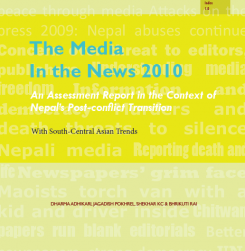
“The Media In the News 2010” released

In a sample of 9,047 headlines on South-Central Asia, aggregated via Google News for the year, India led in the overall coverage of media issues, filling 37% of the newshole. China followed at 28%, Pakistan 11%, Nepal 9%, Sri Lanka 6%, Afghanistan 4%, Bangladesh 3%, Bhutan 1%, and the Maldives 1%.
Releasing the study the lead author of the report and a co-initiator of MF, Dharma Adhikari, said that the year-long maiden study is an effort in evidence-based media criticism and in the future it will be institutionalized as a yearly undertaking.
Regionally, the study found, India’s coverage appeared diverse, with many stories focusing on technology, market and media practices. Two intertwined topics—the explosive growth of the Internet and online censorship practices—accounted for most of the stories on China.
Throughout the year, in Pakistan, Nepal, Sri Lanka and Afghanistan, there was substantial and sometimes intense coverage of the threat to press freedom and violence against journalists. Bangladesh, Bhutan, and the Maldives generated stories that remained spread over a variety of topics. The data revealed a sustained coverage of new media technologies in all the countries.
Nepal’s share of coverage remained more or less steady, except for some fluctuations over the year, due to new developments in the sector, such as ICT events, illegal VOIP channels, the killing of two media entrepreneurs, and new storylines like the direct to home (DTH) television, and newsprint row between Kantipur Publishers and the Indian embassy.
Republica generated 27% of the full-length stories analyzed, followed by The Kathmandu Post (11%), The Himalayan Times (9%), and The Rising Nepal (9%). Two weeklies, Nepali Times and Telegraph, generated 5% and 4% of the content, respectively. Bulk of the content on media (35%) originated in “other” online domestic and foreign sources, which included media watchdog sites, blogs, and wire services.
Among story types, news (62%) was dominant. Op-ed articles comprised 31% and feature stories 7%. Most news stories concerned security of journalists and new media technologies. Op-ed articles and features discussed media profession and entrepreneurship.
The qualitative segment of the analysis focused on media coverage of media in the context of Nepal’s post-conflict transition. The research found that 21% of Nepal stories were related to themes of peace. A close reading of these significant stories revealed that security of journalists and their media institutions was the most dominant topic in the news media coverage of the media.
Stories were analyzed for the external and internal constraints on media practices during the post-conflict situation and their peace-orientation.
External constraints were most visible in the coverage of violence against journalists, their employers and institutions. In the first quarter of the year, news media gave intense focus on the killing of two media entrepreneurs Jamim Shah and Arun Singhaniya. Some newspapers were threatened for covering the Shah story, thereby generating more stories about the beleaguered media.
Incidents of violence against journalists during the week-long Maoist strike in Kathmandu in March also raised the volume of media coverage. Such incidents in Terai and other rural areas were also frequently reported.
Bulk of the stories on attacks on the media comprised statements and condemnations from watchdogs, including IFJ, CPJ, FNJ, and UN agencies.
Generally, stories adopted a defiant tone and cited past incidents of violence against the media to amplify the context. The common thread running through most stories was the call on the government to take strong action against the culprits, end impunity, guarantee safe working conditions for journalists and ensure press freedom.
Stories covering conflict within the media over ethical responsibilities were few and far between. Much of the self-reflection by the media pertained to their own business practices and routine professional values. Nonetheless, there were scattered examples of introspection that touched on some aspects of ethics in conflict situations.
A tape scandal in late 2010 showing Maoist leader Krishna Bahadur Mahara as the source but without verification was one such prominent example. The coverage touched on questions about the potential for media manipulation by sources, authenticating leaks, and their implications for the peace process. Stories scarcely referred to ethnicity, language and nationalism in the context of media coverage of conflict.
Only a few media texts exclusively focused on some aspect of peace-oriented media, explaining the concept or citing real life examples of such practices. However, albeit tangentially, many articles on other themes touched on the issues of peace or war.
Some cases of media manipulation, propaganda, and deception by political parties and businesses were reported and issues of gender stereotyping raised by the news outlets, but they rarely related to post-conflict situations.
Based on recommendations during the floor discussion, it was announced that future annual assessments will include more outlets, genres, languages and special themes.
Download the report here (PDF 2.45 M)
© Media Foudation- 2024 | Site by: SoftNEP